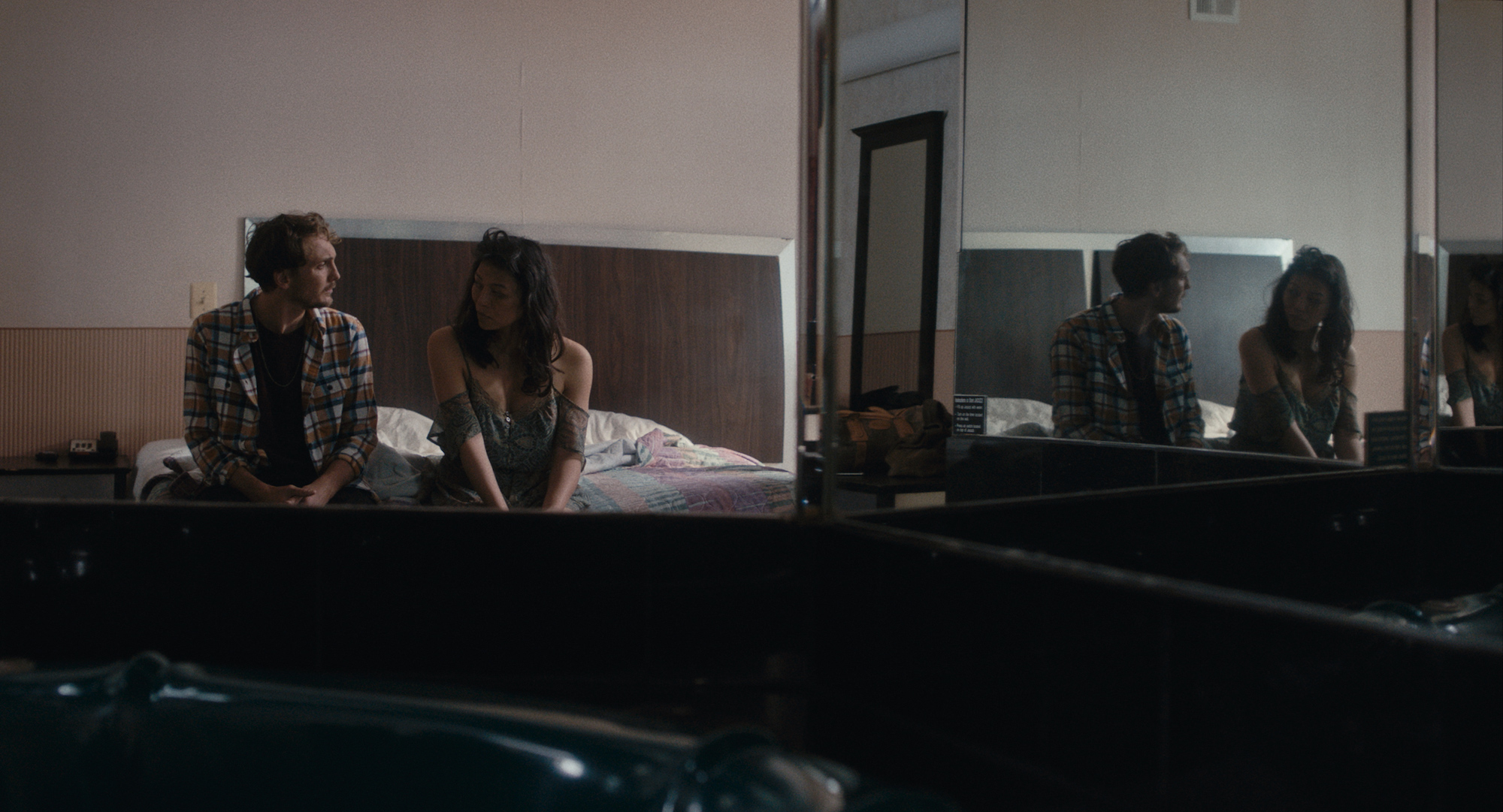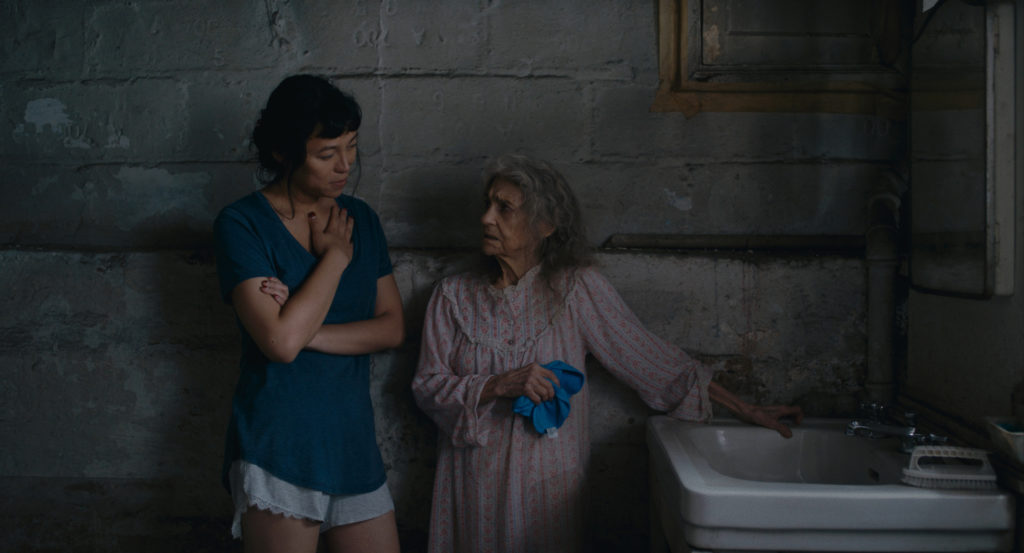In order to bring the story of a disempowered woman in modern-day America to the screen, ISABEL SANDOVAL had to step up to the power position of not only writer and director, but also producer, editor, and lead actor. The result – a romantic drama set in Trump-era Brighton Beach – just finished up a strong festival run and will now have a nationwide release on Netflix.
Sandoval began her filmmaking career with two indie features shot in her native Philippines. She soon took her experiences as a transgender woman of color living in New York and got to work translating it into her first US-set film. The personal story resonated with filmmaking support institutions like IFP, which invited Sandoval to its No Borders program (an experience Isabel wrote about in a series of articles for Filmmaker Magazine).
Filmed over 16 days in Brooklyn and New Jersey, LINGUA FRANCA stars Sandoval as Olivia, a caretaker for an elderly Russian-Jewish immigrant (Lynn Cohen). Olivia begins a relationship with her patient’s down-and-out grandson (Eamon Farren) while living with the fear and uncertainty of her immigration status and identity. Lingua Franca premiered at the 2019 Venice Film Festival, making it the festival’s first film by a trans woman of color. It then extended its reach globally, screening in the US, Canada, UK, Germany, Poland, Belgium, Greece, Slovakia, Australia, India, and South Korea.
ARRAY landed distribution rights to the film and will bring it to select theaters on August 26. We were able to talk to auteur Isabel Sandoval about her career and her new film Lingua Franca.
——
COLIN McCORMACK: Looking back, what was your connection to film while you were growing up in the Philippines?
ISABEL SANDOVAL: For as long as I can remember, I’ve always been in love with movies. Like they say, you don’t choose your passions, your passions choose you. I [was] drawn to movies even as a kid. I remember my mom taking me to a movie theater that was kind like a vintage movie theater built before the Second World War. It was a comedy starring the Charlie Chaplin of the Philippines and his four-year-old son. It was kind of this disposable comedy, but over the years my taste has evolved and matured, and then I sought out arthouse and foreign films. And that was how my sensibility as a director was formed. I also did not go to film school. My film school was watching all those films; those were some of the most amazing and formative experiences for me as an artist.
CM: Was there a desire to perform early on as well, or did that come later?
IS: Yeah, definitely. This is a very ’70s thing, but I consider myself an auteur, and writer/directors when they write their main protagonists, these characters are most likely alter egos and doubles for the writer. So it made sense for me to play those roles. I also think it’s a way of becoming a different person, even in a fictional story. There’s something fascinating to me about that. I think it’s because I’m a Pisces and so I like playing characters that seem different from what I am in public. Kind of accessing different psyches and states of mind.
CM: Where were you in your life when you decided that film was something you wanted to pursue as a career?
IS: I have an undergraduate degree in Psychology and after that, I worked in Brand Management. I was an associate manager for a hair conditioner brand and I think doing that kind of work made me realize that it’s not my calling and the career that I wanted to pursue for the rest of my life. That made me really want to pursue filmmaking. Although I did get my master’s degree in New York shortly after that – I actually have a master’s degree in Business, specializing in marketing and media entertainment – so I was kind of slowly testing the waters and trying to get my foot in the industry. I was interning for the International Distribution Department of Focus Features while I was doing my graduate degree. Then after that I just realized, Who am I kidding? I want to be a filmmaker. So while working media jobs and editing videos and also having a furniture business back home in Manila, I made my first short film and feature.
CM: You already had a career, so how scary was it to finally make that jump of leaving this one world behind and going into another?
IS: I was also being pragmatic in that I didn’t completely leave the other jobs that were paying the bills at that time. But I pursued my art and my passion on my free time and on the weekends. I did take a few months off to shoot my first feature Señorita because I had to travel back to the Philippines to shoot there. So it was a process of slowly extricating myself from other industries and jobs that didn’t make me excited waking up in the morning, into cultivating my passion in filmmaking as a sustainable and lucrative – hopefully – career.
CM: How did you first start making connections with the people who would become your collaborators in filmmaking?
IS: My longest collaborator is actually my producer Darlene Malimas, who is also a good friend of mine. We grew up in the Philippines together and she has been very instrumental in making my first three features. With Lingua Franca – although it’s my third film, it still feels in a way like my first because it’s my first after my gender transition and my first to be set in and produced in the US – I was lucky to have been connected with other Filipino immigrants who are accomplished artists in their fields. One of them is my producer Jhett Tolentino, who is actually from theatre originally. He is a Tony and Grammy Award-winning Broadway producer. My other producer is Carlo Velayo, who had shot an independent feature film starring Stephanie Beatriz that played at SXSW and also produced a Netflix documentary series. So making connections with other minority and Filipino artists like myself really helped me make Lingua Franca a reality.
CM: What did you find was the biggest difference in producing Lingua Franca in the States versus making your other films in the Philippines?
IS: In the States, of course, there’s SAG. So there’s managing these sensitivities and also complying with the rules and the protocols. In terms also of financing, I [was] an unknown entity here in the US when I was trying to put together the financing for Lingua Franca. I mean, I’d made two features, sure, that played at international festivals, but nobody really knows me here. But it’s also been great that there are film institutions that seek to provide funding and support to minority filmmakers like myself. I’ve gotten support from the Tribeca Film Institute, the New York Foundation for the Arts, Frameline, the Jerome Foundation. So Lingua Franca was financed by a combination of private equity, 10% crowdfunding, and these grants. In the Philippines, it was a lot easier to do these things just because the festivals that I’d been to are better well-known in the Philippines, so it was less of a challenge for me to mount my projects there.
CM: Was a crowdfunding campaign always the plan or in developing it and putting things together did you realize that was going to be how you needed to get a chunk of the money?
IS: Because we had friends – particularly among myself and my team of producers – that really wanted to support and chip in to make Lingua Franca happen, but they didn’t have $10,000 laying around, which is kind of our minimum amount for private equity investment. So we set up a fundraising campaign so that they were able to donate money to help finance the film in their own small way. We were very lucky that we accomplished our goal.
CM: As you developed the script, through your own revisions or working with the different foundations, what were the most significant ways it changed and evolved into what it now is as a film?
IS: When I was writing it, Barack Obama was still the president [laughs]. The country felt a lot different. I started writing the film around 2015 when I was transitioning, and halfway through writing it, Trump got elected into the White House. It changed a lot of things temperamentally for the film, especially during those first few months. I was feeling a lot of vulnerability and anxiety and uncertainty about my situation, as did a lot of minorities at that time. That was kind of the mood and the emotional state that I channeled and distilled and I wanted to depict in the film. Even though it has the outlines and elements of a romantic drama, I wanted it to feel true to its time in that there was a lot of paranoia. I wanted to portray a trans woman tentatively navigating these emotional waters that also felt situated in a particular moment in time, and that’s how I felt. So that’s how it changed from a more laid-back and chill type of romantic drama into one that’s more fraught with tension.
CM: In terms of the casting process, what was that like for you? Specifically in casting Eamon in the role of Alex, since you and he have such a connection as characters.
IS: It’s funny because we had actually approached a different actor. I didn’t really know Eamon at that time and that actor has starred in some high-profile films here in the US. So we approached the agent, that actor was unavailable, but the agent read the script and liked it. Eamon asked to read it and he really loved the script and actually sent in a self-tape. Me and the producers were just blown away. Eamon is an extraordinary actor; he has an interesting face and when we did a Skype call – he was based in London at the time – we just hit it off. We made the offer to him shortly after that and we didn’t actually meet in person until a year later about a week-and-a-half before we started shooting.
CM: Wow. The characters are obviously very intimate in the film. This might have been before the job of Intimacy Coordinator was becoming more of the norm, but I’m curious how you and your team helped make the set safe and comfortable for you and for Eamon during some of the more intimate scenes?
IS: It was a closed set. It was really just myself and the cinematographer [Isaac Banks] that were in the room. I had the audacity to shoot it on the very first day of the shoot. Looking back on it now, I would not have done that. I was really feeling extreme pressure – that I imposed on myself – to prove that I could do this, especially since I’m both in front of and behind the camera. As a woman filmmaker, I just wanted to show people that I’m capable. It was nerve-wracking because I’d never shot any kind of sex scene before. In that scene, I felt exposed emotionally. I know I didn’t really show that much in the film, but I still felt naked and also unsettled a little bit. But I did tap into that feeling of being unsettled because that was the environment that Olivia was in for most of the film. So I channeled that energy productively, I think.

CM: Now that the film is ready to be unveiled to the world, what is next for you?
IS: I’m very excited, although it hasn’t been announced yet, but we just closed a deal with a cable network that is ordering a pilot episode of a TV series that I’m developing. It’s produced the likes of American Horror Story, so I guess I’m giving away the name of the cable network [laughs]. Also through this pandemic, I was able to finish the script for my next feature, which is called Tropical Gothic. It’s a 16th-century colonial drama in the Philippines, which is about the haunting of a Spanish colonizer by a native priestess.
CM: Wow, that’s going to be an undertaking. Period pieces are not easy so I wish you all the best. It sounds very exciting.
IS: Thank you so much. Yes, it’s ambitious and risky, and that’s why I’m making it.
__
Thanks to Isabel for discussing LINGUA FRANCA. Get more info about the film at the ARRAY website or follow the film on Facebook or Instagram.
If you’re an independent filmmaker or know of an independent film-related topic we should write about, email blogadmin@sagindie.org for consideration.



